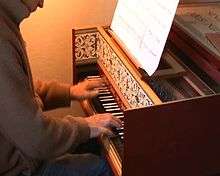Prelude in C minor, BWV 999
 |
Prelude in C minor BWV 999
 Played on harpsichord by Gérard Janot |
| Problems playing this file? See media help. | |
Prelude in C Minor, BWV 999), also termed The "Little" Prelude in C Minor, is a piece written by Johann Sebastian Bach sometime between 1717 and 1723.[1] Though originally composed for Lute-Harpsichord, it has since been adapted for various instruments, including lute, piano and guitar. It is a pedagogical work much in the spirit of The Well-Tempered Clavier, with which it shares musical characteristics. The piece's true authorship fell into question for decades before being proven to be Bach's by publication of Hans Neemann’s J. S. Bach Lautenkompositionen (1931).
History
The piece's exact year of creation is the subject of extensive speculation. The Oxford Dictionary of Music cites the prelude's similarity to the Well-Tempered Clavier (most notably, the sixteenth-note broken chord patterns anchored by a pedal tone [2]), stating, "c minor bwv999 shows an affinity with the ‘48’, and may thus belong to the Cöthen or early Leipzig period".[3] However, indirect sources, such as IMSLP and Classical Music Archives, place its origin at 1725 and 1720, respectively. These estimates also conflict with the more direct motivic parallels between BWV 999 and Prelude and Fugue in C Major, (BWV 846), which Bach penned in 1722. As Bach left Weimar to become Kapellmeister at Cöthen in 1717, and departed Cöthen to take his position as cantor/music director in Leipzig in 1723,[4] the uncertainty of dates (wherein the piece was composed between 1717 and 1723) can place it in any one of three locations within Bach's compositional timeline. Initially, analysts were unsure as to whether the prelude was actually composed by Bach, since the only original source discovered was a copy by one of Bach's pupils, Johann Peter Kellner (1705-1772). Analysis contained within Neemann’s J. S. Bach Lautenkompositionen (1931) later confirmed the authorship.
Prelude genre
BWV 999's brief, introductory nature (43 measures), improvisatory feel and reiteration of a defining motif fits squarely within the prelude genre of the early 1710s/20s. Additionally, the shortness of the motif itself follows the conventions of early sixteenth-century prelude. It also served a teaching purpose characteristic of the genre, widely using arpeggiations and technical demands that served students well as an etude. Barbara Russano Hanning describes prelude features and goals: "The typical prelude assigns the player a specific task, so that the piece functions as an etude. In addition, the preludes illustrate different types of keyboard performance conventions and compositional practices."[5] Such pedagogical traits contribute to the work's longevity; it is still an oft-used educational tool.
Musical characteristics
Motif
Prelude in C Minor is set in 3/4 time. Its central motif consists of intersecting rhythms between the upper and lower voice (what originally would have been the left and right hand). In the right hand, this is a sixteenth rest, followed by a seven-note sixteenth passage that typically arpeggiates an inversion of a triad (ascending and descending from/back to the root), and an alternating sixteenth rest/sixteenth note pattern in the third beat. The left participates by having a pedal tone quarter in the first beat, a rest, then two eighth notes.
Harmony
Contrary to its title and key signature, less than a third of BWV 999 is actually written in C minor. In measure 11, a Secondary leading-tone chord is employed (namely, a diminished F♯ seventh chord) to modulate and lead the ear to G minor, the dominant of the original key. Aside from a turn to G Major (m. 34-38; 42-end), and the reemergence of C Minor (m. 39-41), G minor tonality dominates the piece. Early on, the left hand/upper voice is repeated over several measures, with the left hand providing the only shifting harmonic background. For example, measures 8-10 are exactly the same in the right hand, but descending tones in the left hand create an expansion of tonic harmony.
Publication
The prelude was first published as a keyboard piece, No. 3 of the Twelve Little Preludes, in 1890.[6]
References
- ↑ Schulze, Hans-Joachim (1986). The Bach Compendium. Leipzig: Peter Lang. ISBN 3-87626-130-9.
- ↑ "Prelude and Fugue in C major, BWV 846 (Bach, Johann Sebastian) - IMSLP/Petrucci Music Library: Free Public Domain Sheet Music". imslp.org. Retrieved 2015-12-02.
- ↑ Wolff, Christoph (2015). "Oxford Dictionary of Music". Johann Sebastian Bach. Oxford University Press. Retrieved 2015-11-03.
- ↑ Hanning, Barbara Russano (2014). Concise History of Western Music. New York: W.W. Norton & Company. p. 274. ISBN 978-0-393-92066-6.
- ↑ Hanning, Barbara Russano (2014). Concise History of Western Music. New York: W.W. Norton & Company. p. 278. ISBN 978-0-393-92066-6.
- ↑ Ernst Naumann. BGA Vol. 36 (1890), pp. 118–127